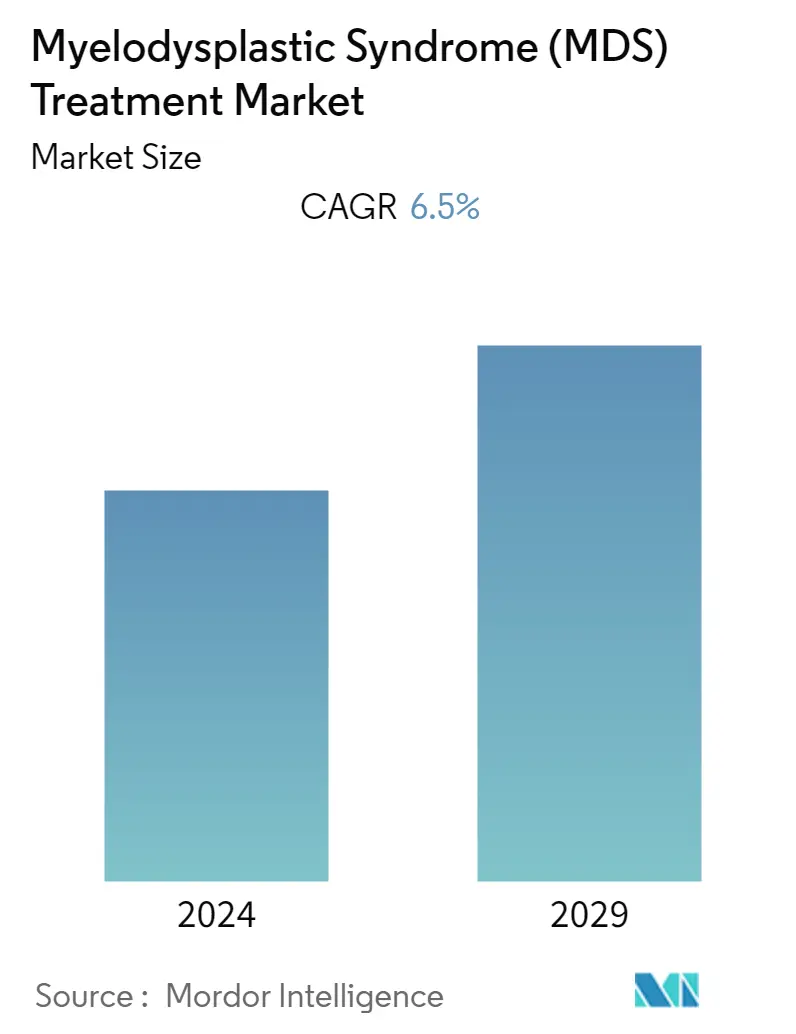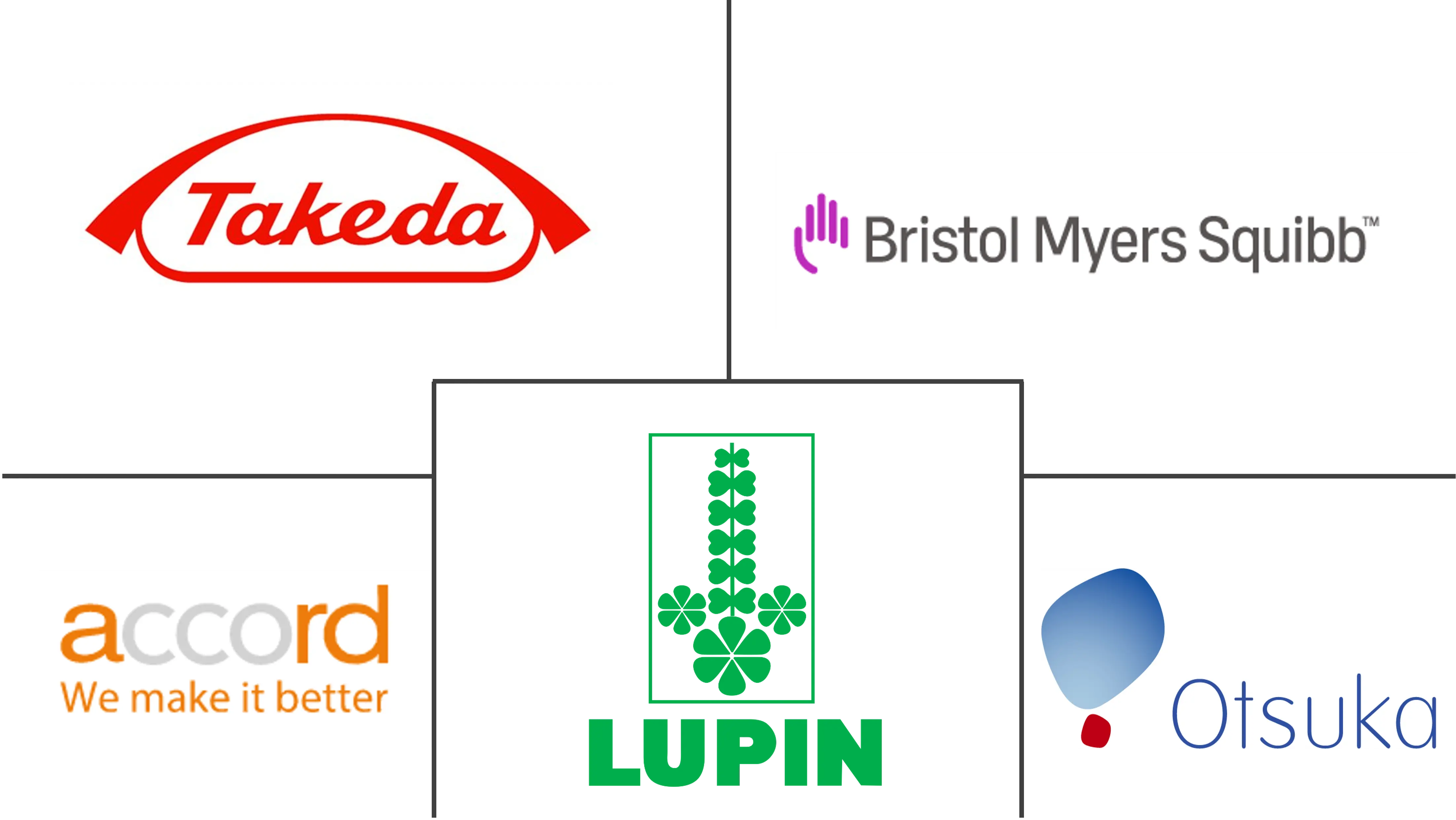Market Size of Myelodysplastic Syndrome (MDS) Treatment Industry

| Study Period | 2019 - 2029 |
| Base Year For Estimation | 2023 |
| Forecast Data Period | 2024 - 2029 |
| CAGR | 6.50 % |
| Fastest Growing Market | Asia Pacific |
| Largest Market | North America |
Major Players
*Disclaimer: Major Players sorted in no particular order |
Myelodysplastic Syndrome Treatment Market Analysis
The myelodysplastic syndrome (MDS) treatment market is projected to register a CAGR of 6.5% during the forecast period, 2022-2027.
The COVID-19 (SARS-CoV-2) pandemic has had a variety of effects on cancer patients, including diagnostic and treatment delays, blood product scarcity, and, most importantly, increased morbidity and mortality from viral infection. For instance, as per the article titled "Myelodysplastic Syndromes (MDS) & COVID-19: Clinical Experience from the United States Epicenter of the Pandemic", published in November 2020, records were reviewed of all patients seen in the MDS clinic of a large New York City tertiary academic medical center between March 12 and May 07, 2020. Among 85 patients seen in the clinic, 23 were found to have COVID-19. Nonetheless, such factors ultimately affected cancer care, causing the therapeutic pathway for MDS patients to be disrupted. This disruption to standard clinical care was exacerbated by the fear that COVID-19 would increase morbidity and mortality in immunocompromised MDS patients. There were fewer data available to guide treatment or protective recommendations in the early days of the pandemic, and advice was limited to expert opinion. Care interruptions had manifested as limited access to laboratory appointments for blood work assessment patients whose diseases required close observation and monitoring. Thus, the blood shortage had a significant impact on patients who required transfusional support, particularly those who lived in regions with few transfusion facilities. Patients undergoing chemotherapy also had to contend with shortened clinic or infusion center hours and inaccessible providers.
Furthermore, ongoing concern among chemotherapy patients that the resulting immunosuppression could make them more susceptible to COVID-19 infection and severe disease has shifted the balance between the risks and benefits of chemotherapy in many cases. As a result of the COVID-19 pandemic, the market studied has been impacted to a greater extent. However, with ongoing vaccinations and decreasing COVID-19 cases, the market studied is expected to regain its full potential during the forecast period.
The global market for myelodysplastic syndrome (MDS) treatment is expected to grow significantly over the coming years, owing to rising pipeline products and product approvals, as well as increased R&D investments in the development of novel drugs for MDS. For instance, Inqovi (decitabine and cedazuridine) tablets were approved by the United States Food and Drug Administration in July 2020 for the treatment of adult patients with myelodysplastic syndromes (MDS) and chronic myelomonocytic leukemia (CMML). This is a significant advancement in treatment options for patients with MDS, a type of blood cancer which previously required intravenous therapy at a healthcare facility.
Thus, the aforementioned factors are anticipated to contribute to the growth of the myelodysplastic syndrome (MDS) treatment market. However, side effects associated with the medications are likely to impede the market's growth.
Myelodysplastic Syndrome Treatment Industry Segmentation
As per the scope of the report, myelodysplastic syndrome (MDS) is a group of diverse bone marrow disorders in which the bone marrow does not produce enough healthy blood cells. MDS is often referred to as a "bone marrow failure disorder." These disorders are characterized by ineffective hematopoiesis, including abnormalities in proliferation, differentiation, and apoptosis. The Myelodysplastic Syndrome (MDS) Treatment Market is segmented by Treatment Type (Chemotherapy, Immune Treatments, Stem Cell Transplant, Other Treatment Types), End-User (Hospitals, Specialty Clinics, and Other End Users), and Geography (North America, Europe, Asia-Pacific, Middle-East and Africa, and South America). The market report also covers the estimated market sizes and trends for 17 different countries across major regions, globally. The report offers the value (USD million) for the above segments.
| By Treatment Type | |
| Chemotherapy | |
| Immune Treatments | |
| Stem Cell Transplant | |
| Other Treatment Types |
| By End User | |
| Hospitals | |
| Specialty Clinics | |
| Other End Users |
| Geography | ||||||||
| ||||||||
| ||||||||
| ||||||||
| ||||||||
|
Myelodysplastic Syndrome (MDS) Treatment Market Size Summary
The myelodysplastic syndrome (MDS) treatment market is poised for significant growth, driven by advancements in drug development and increasing product approvals. The market is expected to expand due to rising investments in research and development aimed at creating novel therapies for MDS, a type of blood cancer. The approval of new treatments, such as Inqovi, which offers an oral alternative to intravenous therapy, highlights the progress in treatment options available to patients. Despite the challenges posed by the COVID-19 pandemic, which disrupted standard care and affected patient access to necessary treatments, the market is anticipated to recover and regain its momentum. The ongoing vaccination efforts and decreasing COVID-19 cases are expected to further support the market's recovery during the forecast period.
North America leads the global MDS treatment market, attributed to the high prevalence of the condition, early adoption of innovative treatments, and substantial investments in drug development. The region's sophisticated healthcare infrastructure and increasing patient awareness also contribute to market growth. The rapid pace of product approvals, such as those granted to Takeda Pharmaceutical Company Limited and Novartis for their investigational drugs, is expected to enhance treatment options and improve patient outcomes. Major industry players, including AbbVie and Bristol-Myers Squibb, are actively expanding their market presence through strategic partnerships and collaborations. These factors collectively are likely to bolster the growth of the MDS treatment market, particularly in North America.
Myelodysplastic Syndrome (MDS) Treatment Market Size - Table of Contents
-
1. MARKET DYNAMICS
-
1.1 Market Overview
-
1.2 Market Drivers
-
1.2.1 High R&D Investments on the Development of Novel Treatments for MDS
-
1.2.2 Strong Presence of Pipeline Drugs
-
-
1.3 Market Restraints
-
1.3.1 Side Effects Associated with the Medications
-
-
1.4 Porter's Five Forces Analysis
-
1.4.1 Threat of New Entrants
-
1.4.2 Bargaining Power of Buyers/Consumers
-
1.4.3 Bargaining Power of Suppliers
-
1.4.4 Threat of Substitute Products
-
1.4.5 Intensity of Competitive Rivalry
-
-
-
2. MARKET SEGMENTATION (Market Size by Value - USD million)
-
2.1 By Treatment Type
-
2.1.1 Chemotherapy
-
2.1.2 Immune Treatments
-
2.1.3 Stem Cell Transplant
-
2.1.4 Other Treatment Types
-
-
2.2 By End User
-
2.2.1 Hospitals
-
2.2.2 Specialty Clinics
-
2.2.3 Other End Users
-
-
2.3 Geography
-
2.3.1 North America
-
2.3.1.1 United States
-
2.3.1.2 Canada
-
2.3.1.3 Mexico
-
-
2.3.2 Europe
-
2.3.2.1 Germany
-
2.3.2.2 United Kingdom
-
2.3.2.3 France
-
2.3.2.4 Italy
-
2.3.2.5 Spain
-
2.3.2.6 Rest of Europe
-
-
2.3.3 Asia-Pacific
-
2.3.3.1 China
-
2.3.3.2 Japan
-
2.3.3.3 India
-
2.3.3.4 Australia
-
2.3.3.5 South Korea
-
2.3.3.6 Rest of Asia-Pacific
-
-
2.3.4 Middle-East & Africa
-
2.3.4.1 GCC
-
2.3.4.2 South Africa
-
2.3.4.3 Rest of Middle-East & Africa
-
-
2.3.5 South America
-
2.3.5.1 Brazil
-
2.3.5.2 Argentina
-
2.3.5.3 Rest of South America
-
-
-
Myelodysplastic Syndrome (MDS) Treatment Market Size FAQs
What is the current Myelodysplastic Syndrome (MDS) Treatment Market size?
The Myelodysplastic Syndrome (MDS) Treatment Market is projected to register a CAGR of 6.5% during the forecast period (2024-2029)
Who are the key players in Myelodysplastic Syndrome (MDS) Treatment Market?
Takeda Pharmaceutical Company Limited , Bristol-Myers Squibb, LUPIN, Accord Healthcare and Otsuka America Pharmaceutical, Inc. are the major companies operating in the Myelodysplastic Syndrome (MDS) Treatment Market.

